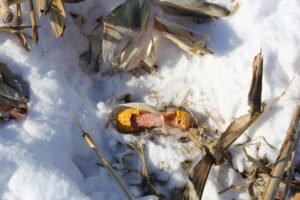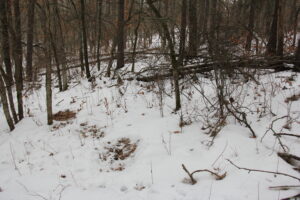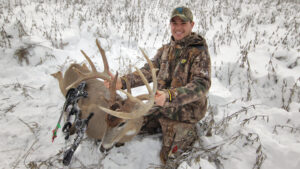Don’t despair if you still haven’t wrapped your tag around a buck. This is one of the best times of the year to hunt if you can handle the harsh weather.
By Bernie Barringer
Here I am with a deer tag in my pocket and it’s almost Christmas. It’s not the first time I let this happen and I am sure it won’t be the last. In fact, I tend to be rather indifferent about shooting a deer until winter hits, unless a great opportunity presents itself. The harsh weather of winter offers one of the best times of the year to catch a buck with his guard down.
I love hunting the last days of archery season despite the nasty weather because I have so many good memories and successes to show for it. Many states have bow and muzzleloader seasons that last beyond Christmas and well into January. The key to success for me has been the understanding that the deer have different needs during cold weather than they do during the rest of the hunting season. The key is finding standing farm crops that offer the nutrients they crave at this time of the year.
After the rut, bucks are run down. Their fat reserves are gone, and even their muscle mass is diminished. Nothing restores muscle faster that protein, and soybeans are loaded with protein. Field corn is very high in carbohydrates, which help restore fat reserves. Most mast crops are super high in carbohydrates and fat.

Corn fields left standing in December into early January will be swarmed by deer. In cut corn fields, deer will glean waste corn from the ground as long as it is available, and they can easily smell even a single kernel through a foot of snow.
Since soybeans provide quick energy through a combination of proteins and carbs, deer will often seek them out during the coldest weather. A stretch of below-zero weather will move deer off the corn and acorns and onto the soybeans because of the quick turnaround of energy they offer. During these periods of deep freeze weather, immediate energy for body heat is more important that storage of fat. Food plots of soybeans or late-standing soybean fields attract more deer than corn does during the harshest weather. When the weather moderates, they may move back to the high-carb food sources.
When not feeding, bucks need to feel secure in bedding areas that provide them protection from the elements. Thick cover offers protection from biting winter winds, and on cloudy or snowy days, most deer will be tucked in tight right in the middle of the thickest stuff around. And they will use the same beds day after day.
The second most common bedding areas in the winter are south-facing open slopes that get a lot of sun. Whitetails tend to use these areas when there is little wind and they can soak up the sun’s warming rays. Look for open timber where the sun can get through. These areas will typically have a lot of beds because the deer will get up and move as the shadow of a tree falls on them. So they may actually use 3-4 beds during the course of the day.
Well-worn trails provide evidence of travel patterns that can help the bowhunter decide where to set up an ambush. A ground blind along the edge or blended in with cornstalks right in the middle of the food is often the perfect spot.
It is very common for bucks to approach the field through thick cover, and make their way out into the field cautiously. The most mature bucks will typically enter the field last; they hang back and watch the posture and actions of the does which enter the fields first.
For me, getting on these bucks involves a two-part plan. The first stand I set up when I find a field with a lot of deer using it is what I call an observation stand. I will put the stand up on the downwind side of the field where I can see a large area. I am not so concerned about being within range of the deer, my primary objective is to see where they are coming into the field.
Once I get a handle on where the bucks are most likely to enter the field, it’s time to strike. I like to set up about 50 yards back off the edge of the field on the downwind side of the trail they are using. Usually the trails are obvious because they can’t hide what they are doing when snow covers the ground.
Because the mature bucks tend to come out last, the downwind approach is critical because it allows the does and smaller bucks to move by you without catching your wind. The target bucks will take their time and hang back off the edge of the field, right where you are set up.
So if you are like me and have hung onto your tag until the last minute; don’t despair, just bundle up and grind it out. Find the foods and you will find the deer.
